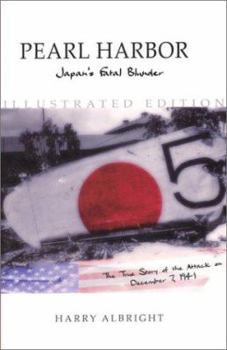Pearl Harbor: Japan's Fatal Blunder
Select Format
Select Condition 
Book Overview
In this gripping narrative, the author reviews the decisions made by Admiral Nagumo, the Japanese strike force commander, and his chief of staff, Admiral Kusaka, and examines the battle of Midway, in... This description may be from another edition of this product.
Format:Paperback
Language:English
ISBN:0781810183
ISBN13:9780781810180
Release Date:December 2003
Publisher:Hippocrene Books
Length:378 Pages
Weight:1.26 lbs.
Dimensions:1.0" x 6.0" x 8.3"
Customer Reviews
1 rating
Excellent combination of history and speculation
Published by Thriftbooks.com User , 16 years ago
Retired G-2 Intelligence Captain Albright's book provides a succinct and accurate summary of how Japan's Pearl Harbor attack went wrong. - Japan controlled most all islands in the Pacific, with the U.S. limited primarily to Aleutians, Midway, Hawaii, Howland, Wake, Guam, and some of the Philippines. - Japan's attack hit just one row of 18 U.S. capital ships, out of some 400 overall in Pearl Harbor, plus supporting airfields. - Japan's December 7 attack was intended to discourage the USA from challenging Japanese hegemony in Southeast Asia. At stake there were oil, rubber, tin, and other important resources to support imperial power. Japan miscalculated. - Japan's terrible blunder was in not destroying Pearl Harbor's oil reserves, machine shops, and submarine pens - so as then to invade and dominate the Hawaiian Islands and preempt the USA from carrying on war in the Pacific. After summarizing history, Captain Albright's book continues with fictional speculation, and very effectively and engagingly at that. Had Japan decided to take Hawaii and preempt U.S. military might in the Pacific, what would have been intelligent strategy and tactics? - First of all, a third strike that would have taken out the oil reservoir, submarine pens, and machine shops - as Harvard-educated Admiral Isoroku Yamamoto later regretted not doing. - Next, to take Kauai's Hanalei Bay and base a portion of the Japanese fleet there to carry on the Oahu invasion. - With the U.S. Pacific fleet seriously disabled, Japanese prospects for taking all of Hawaii would have been good but still uncertain. Albright weaves a fascinating tale of hypothetical tactics, deceptions and countermoves by both sides from there. - The outcome of Albright's speculations is left inconclusive, which should stimulate the reader's own research and explorations of strategies and tactics. It's all in all a most lively and important book for historians and laymen alike to ponder.




